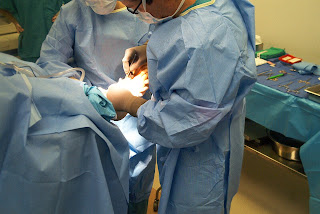
It was a difficult decision, but you've decided to no longer put
up with the pain, irritation, and deformity of a bunion or hammer toe.
In my case, it was a severe bunion, with my big toe drifting
aggressively towards my other toes, which informed my decision towards
major foot surgery. My husband had undergone bunion surgery more than
ten years earlier, and this trying experience, both for him as patient
and myself as caregiver, had cautioned us both to plan ahead.The
devil is, indeed, in the details. Knowing that you'll be off of your
feet for at least three weeks, and walking with limited mobility in a
surgical shoe or boot for as long as eight weeks, takes strategic
planning. It's easy to remember to gather books, DVDs, and magazines in
advance of your surgery, but there's much more that can be done to make
your confinement a stress-free experience.
- Contact your doctor's office, and pick up prescriptions in advance for any medications or devices, such as crutches, that you'll need. Your doctor may also be able to sign a form for a temporary handicapped parking placard.
- Most insurance won't cover crutches or other assistance devices until two days before your surgery. Be sure you know what your insurance will cover, and when and where you'll need to pick up materials. A rolling scooter called a knee-walker, such as a Roll-About, is a life-saver and will give you more stability than crutches. Knee-walkers may be rented at your local medical supply company, or on-line.
- Freeze ice packs in advance. Icing, even weeks after your surgery, will help keep down foot swelling. A small cooler by your bed filled with ice packs will allow you to change them frequently right after surgery. A handy way to keep the ice packs on your foot is to secure them with a long Ace bandage.
- Even after your stitches come out, you'll want to put a dressing on your scar to minimize irritation. Purchase gauze pads, surgical tape and stretchy "tender tape" in advance.
- Your doctor may recommend purchasing a compression sock to minimize swelling. You can also use a tight Ace bandage or purchase an inexpensive forefoot compression sleeve at http://www.therawear.com/foot-and-lower-body-health.html?brand=120&cat=31 . Be aware that you'll also need a big, loose sock to slip over your swollen foot. My husband's wool tube socks were perfect.
- Your foot will need to be elevated as much as possible during your entire recovery. I was given a handy foam block at the hospital. Have pillows at the ready, or purchase a foam block, about 5" in height, from a craft store.
- Place a small table by your bedside. Have anything you may need within arm's reach, such as a water bottle, lip balm, TV remote, telephone, and medications. Another similar table or tray by your couch is useful. A 4-legged cane with a curved handle placed by the bed can act as a bed-rail, and will assist with getting in and out of bed during the first weeks after surgery.
- Stock up on easy-to-prepare meals, such as frozen foods that can be popped in the microwave. Even after you can walk, a trip to the grocery store will be impractical. Have lots of bottled water on hand.
- Catch up on your laundry. Laundry baskets will be hard to handle, and if your washer and dryer are located in your basement, it will be weeks until you can manage a wash. Inventory and launder casual clothes in advance, and be sure you have a few pairs of wide-legged pants that can be slipped over your surgical boot.
- You are at your most vulnerable when bathing. Your doctor may allow you to get your foot wet as soon as a week after surgery, even with the stitches still in, so your foot will still be very tender and unable to bear weight. You'll want to have the following for a safe bathing experience:
- Shower stool
- Sprayer shower-head
- Grab-bars around the tub
- Shower gel and wash cloths (rather than soap)
- Large plastic bags (if your doctor recommends keeping your foot dry)
- You'll want to have a comfy, easy to slip on shoe that is close to the height of your surgical boot. Since your foot will be elevated much of the time, you'll also want a comfortable slipper for your non-surgical foot. I found that most of my shoes were the wrong height, so www.zappos.com was a convenient way to shoe-shop while confined.
- Will you need to navigate stairs? Using crutches is dangerous - until you can walk in your boot, it's better to find an alternative method. I went up and down on my butt; my husband used construction knee-pads and went up the stair on his knees. Plan a strategy and practice in advance.
The final, and most important
question, is how to keep your spirits up during a long recovery. Make a
list of projects that can be done while you're home and on the couch -
photos that you've meant to organize, books and movies that you've
planned to catch up on, the computer game that you've never had time to
learn. Gather your project supplies in advance of your surgery. Think of
this time of healing not as a forced confinement, but as a period of
rest and relaxation. Advanced planning will not only be easier on you,
but on your caregiver as well.
Joan Elmouchi is a librarian who lives outside of Detroit,
Michigan. She is the author of the Travel Guide "Beach Freaks' Guide to
Michigan's Best Beaches", published by Glovebox Guidebooks. Joan is a
board member and past-president of the prestigious Metro-Detroit Book
& Author Society, past-president of the Women's National Book
Association, and a member of the writer's groups OWWL and First Draft
Writers.
Article Source:
http://EzineArticles.com/?expert=Joan_Elmouchi











0 comments:
Post a Comment